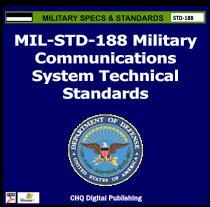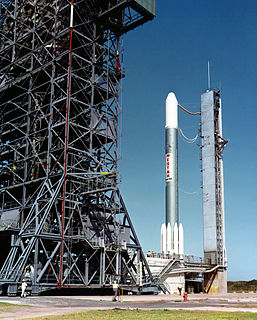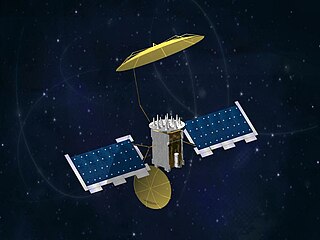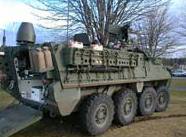
MIL-STD-188 is a series of U.S. military standards relating to telecommunications.

A communications satellite is an artificial satellite that relays and amplifies radio telecommunications signals via a transponder; it creates a communication channel between a source transmitter and a receiver at different locations on Earth. Communications satellites are used for television, telephone, radio, internet, and military applications. There are about 2,000 communications satellites in Earth's orbit, used by both private and government organizations. Many are in geostationary orbit 22,236 miles (35,785 km) above the equator, so that the satellite appears stationary at the same point in the sky, so the satellite dish antennas of ground stations can be aimed permanently at that spot and do not have to move to track it.

Westar 1 was America's first domestic and commercially launched geostationary communications satellite, launched by Western Union (WU) and NASA on April 13, 1974. It was built by Hughes for Western Union, using the HS-333 platform of spin-stabilized satellites. Westar 1 was the first of five Westar satellites launched by Western Union from 1974 to 1982. Westars 1, 2, and 3 were 12-transponder satellites while Westar 4 and Westar 5 were launched with 24 transponders. Western Union built a teleport in Cedar Hill, Texas, to uplink content to the Westar satellites, and another teleport that, in addition to uplink services, would become the main TT&C center for the satellite, in Glenwood, New Jersey. A sixth satellite, Westar 6, was launched in 1984 but failed to reach orbit and was retrieved by the STS-51-A Space Shuttle mission later that year. It was later refurbished and relaunched in orbit of Asia as AsiaSat 1 in 1990.

The Mobile User Objective System is a narrowband military communications satellite system that supports a worldwide, multi-Service population of users in the ultra high frequency band. The system provides increased communications capabilities to newer, smaller terminals while still supporting interoperability with legacy terminals. MUOS is designed to support users who require greater mobility, higher bit rates and improved operational availability.

The Satcom series was a family of communications satellites originally developed and operated by RCA American Communications. Satcom was one of the early geostationary satellites; the first were the Syncom series, in 1964. The first Satcom satellite, Satcom 1, was launched on December 13, 1975. The last satellite, Satcom K2, was placed into orbit on November 27, 1985 and was de-orbited in February 2002. Satcom was first superseded and then replaced by the GE series of satellites.
SES Americom was a major commercial satellite operator of North American geosynchronous satellites based in the United States. The company started as RCA Americom in 1975 before being bought by General Electric in 1986 and then later acquired by SES S.A. in 2001. In September 2009, SES Americom and SES New Skies merged into SES World Skies.
COMSAT, Inc. is a leading operator of customized, secure end-to-end satellite communications services. COMSAT delivers a full portfolio of fixed satellite solutions, mobile satellite solutions, and teleport services to aeronautical, land-mobile, and maritime users in multiple markets, including U.S. government and military, global governments and commercial maritime. COMSAT is wholly owned by Satcom Direct (SD). SD offers global communications services, support, and technology to business and general aviation, military, government, emergency response, media, and others who depend on reliable, global communications. SD supports customers via locations around the globe including our world headquarters and network operations center (NOC) located in Melbourne, Florida.

Satcom on the Move (SOTM), or satellite communications on the move, is a phrase used in the context of mobile satellite technology, specifically relating to military ground vehicles, Maritime and Airborne platforms. The basic principle behind Satcom On The Move is that a vehicle equipped with a satellite antenna is able to establish communication with a satellite and maintain that communication while the vehicle is moving.
Skynet 5A is the first in a series of new-generation Skynet military communications satellites, used by the British Ministry of Defence. It was launched aboard an Ariane 5 carrier rocket at 22:03 GMT on 11 March 2007.

The Wideband Global SATCOM system (WGS) is a high capacity satellite communications system planned for use in partnership by the United States Department of Defense (DoD) and the Australian Department of Defence. The system is composed of the Space Segment satellites, the Terminal Segment users and the Control Segment operators.

USA-195, or Wideband Global Satcom 1 (WGS-1) is an American military communications satellite operated by the United States Air Force as part of the Wideband Global Satcom programme. Launched in 2007, it was the first WGS satellite to reach orbit. It is stationed at a longitude of 174.8° east.

The Military Satellite Communications Systems Wing (MCSW) is a United States Air Force organization headquartered at Los Angeles Air Force Base, California. It is one of several wings and other units that make up the Air Force Space Command's Space and Missile Systems Center (SMC).
SwiftBroadband is an IP-based packet-switched communications network that provides a symmetric ‘always-on’ data connection of up to 650 kbit/s per channel for aircraft globally except for the polar regions, using the Inmarsat satellite constellation.

USA-204, or Wideband Global Satcom 2 (WGS-2) is an American military communications satellite which is operated by the United States Air Force as part of the Wideband Global Satcom programme. Launched in 2009, it was the second WGS satellite to reach orbit, and operates in geostationary orbit at a longitude of 60° east.

USA-211, or Wideband Global Satcom 3 (WGS-3) is an American military communications satellite operated by the United States Air Force as part of the Wideband Global Satcom programme. Launched in 2009, it was the third WGS satellite, and final Block I spacecraft, to reach orbit. It is stationed at 12° west in Geostationary orbit.

USA-244, or Wideband Global Satcom 6 (WGS-6) is an American military communications satellite operated by the United States Air Force as part of the Wideband Global Satcom programme. Launched in 2013, it was the sixth WGS satellite to reach orbit. It is stationed at a longitude of 104° east, in geostationary orbit. WGS-6 was procured by the Australian Defence Force for the US Air Force, in exchange for participation in the programme.
X band or SHF Satellite Communication is widely used by military forces for beyond line of sight communications. X band is used because it provides a compromise between the characteristics of different frequency bands which is particularly suited to the needs of military users. The characteristics include interference and rain resilience, terminal size, data rates, remote coverage and whether it is reserved for governmental use.
A satellite data unit (SDU) is an avionics device installed in an aircraft that allows air/ground communication via a satellite network. It is an integral part of an aircraft's SATCOM system. The device connects with a satellite via ordinary radio frequency (RF) communication and the satellite then connects to a ground station or vice versa. All satellite communication whether audio or data is processed by the SDU.

Globalsat Group is a consortium of companies providing satellite communication services worldwide with headquarters located in the United States. The companies that are currently part of the consortium include:
China Satellite Communications Co., Ltd. known as China Satcom is a Chinese aerospace company that provides services via satellites. The company was a subsidiary of China Aerospace Science and Technology Corporation (CASC).









